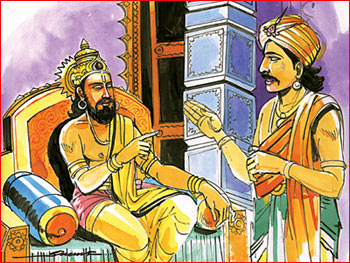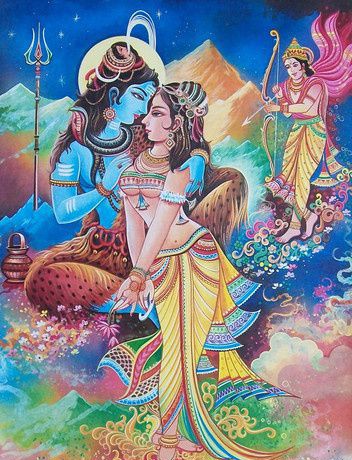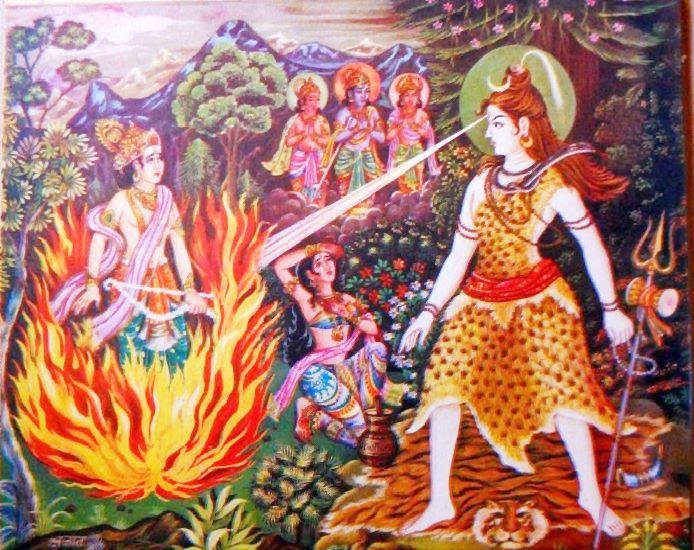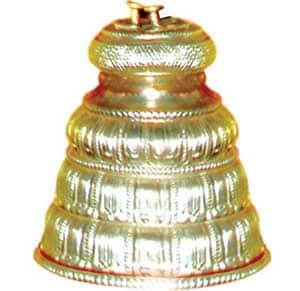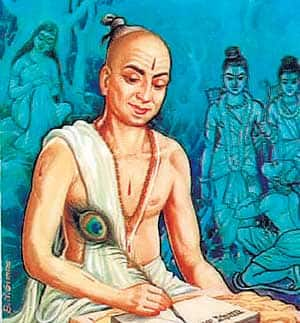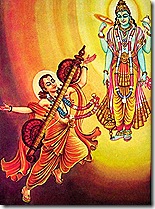P.J.
0
சொர்க்கமா..? வேண்டவே வேண்டாம்!’
சொர்க்கமா..? வேண்டவே வேண்டாம்!’
முத்கலர், சிறந்த தவசீலர். ஞானி. பண்பும் பகுத்தறிவும் மிகுந்தவர். தயாள குணத்தால் புகழ் பெற்றவர். ஒரு முறை இவரது குடிலுக்கு, துர்வாச முனிவர் வருகை தந்தார். மகிழ்ச்சியுடன் அவரை வரவேற்றனர் முத்கலரின் குடும்பத்தார். துர்வாசரிடம், ”ஸ்வாமி, தாங்கள் இன்று இங்கு தங்கி, உணவருந்திச் செல்ல வேண்டும்!” என்று பணிவுடன் வேண்டினார் முத்கலர்.
”எனக்கு விருந்து படைக்க உம்மால் இயலுமா?” - சற்று ஏளனத்துடன் கேட்டார் துர்வாசர். ”எளியேனிடம் இருப்பதை வைத்து உபசரிக்கிறேன்… பெருந்தன்மையுடன் ஏற்று அருள வேண்டும்!”- மாறாத புன்னகையுடன் பதிலளித்த முத்கலர் விருந்து ஏற்பாடுகளைக் கவனிக்கத் தொடங்கினார்.
நதிக்கரைக்குச் சென்ற துர்வாசர் நித்திய கர்மானுஷ்டங்களை முடித்து வந்தார். முத்கலரும் அவரின் மனைவியும், துர்வாசருக்கு விருந்து படைத்தனர்.
எளிமையான விருந்தாயினும் சுவையாக இருந்தது. மன நிறைவுடன் சாப்பிட்டு முடித்தார் துர்வாசர். பெரும் ஏப்பத்துடன் எழுந்தவர், ஆசி கூட கூறாமல் அங்கிருந்து கிளம்பிச் சென்றார்.
பத்து நாட்களுக்குப் போதுமான
தானியங்களை உணவாக்கி துர்வாசருக்குப் படைத்தாகி விட்டது. அன்றும் அடுத்து வரும் நாட்களிலும் அரை வயிற்றுக் கஞ்சிதான் உணவு. தொடர்ந்து பத்து நாட்கள்… முத்கலர் வயல் வெளிக்குச் சென்று தானியங்கள் சேகரித்து வந்தால், பதினோராவது நாள் முழுச் சாப்பாடு கிடைக்கும்.நாட்கள் கழிந்தன. பதினோராவது நாள், மிகச் சரியாக… முத்கலரும் அவரின் குடும்பத்தாரும் சாப்பிட அமர்ந்த வேளையில் அங்கு வந்து சேர்ந்தார் துர்வாசர்! முத்கலர், இதை சற்றும் எதிர்பார்க்கவில்லை. எனினும் முகமும் அகமும் மலர துர்வாசரை வரவேற்றார்.
"வரவேற்பு மரியாதைகள் எல்லாம்
இருக்கட்டும் எனக்கு,பசி காதை அடைக்கிறது.
இன்று இங்குதான் உணவருந்தப் போகிறேன். சமையல் தயாரா?”என்றார் கடுகடு
முகத்துடன். மறுகணம் வாழையிலை விரிக்கப்பட்டது.
தங்களுக்காக தயார் செய்த உணவை, இன்முகத்துடன் துர்வாசருக்குப் பரிமாறினர் முத்கலர் தம்பதி. அன்றும் திருப்தியான சாப்பாடு. உண்டு முடித்த துர்வாசர், வழக்கம் போல எதுவும் பேசாமல் புறப்பட்டு விட்டார்.
முத்கலர் குடும்பத்தாரது அரைப் பட்டினி நிலை தொடர்ந்தது. எனினும், அவர்கள் எவரும் இம்மியளவேனும் முகம் கோணவில்லை. நித்திய கர்மானுஷ்டங்களை செய்வதும், எஞ்சியுள்ள நேரத்தில் வயல்வெளிக்குச் சென்று தானியங்கள் சேகரித்து வருவதும் வழக்கமானது.
சரியாக பதினோராவது நாள்… அழையா விருந்தாளியாக மீண்டும் துர்வாசர்! இந்த முறையும் மகிழ்ச்சியுடன் அந்த முனிவரை உபசரித்து விருந்து படைத்து அனுப்பினர்.
இப்படி தன் குடும்பத்தார் அரை வயிற்றுக் கஞ்சியுடன் காலம் கழிப்பதும், முத்கலர் தானியங்கள் சேகரித்து வருவதும், பதினோராவது நாள் துர்வாசர் வந்து உணவைக் காலிசெய்து விட்டுப் போவதும் தொடர்கதையானது.
இரண்டு மாதங்கள் கழிந்தன. துர்வாசர் வருவது… இது, ஏழாவது முறை! ஆனால் அன்று அவரின் முகத்தில் வழக்கத்துக்கு மாறாக ஒருவித மலர்ச்சி!
வந்ததும் பேச ஆரம்பித்தார்: ”முத்கலரே… உமது திட சிந்தையையும் விருந்தோம்பும் பண்பையும் சோதிக்கவே இப்படி ஒரு பரீட்சை. அதில் நீர் வென்று விட்டீர். உமக்கும் குடும்பத்துக்கும் ஒன்றையும் மிச்சம் வைக்காமல் நான் சாப்பிட்டுச் சென்றாலும், ஒவ்வொரு முறையும் இன்முகத்துடன் நீங்கள் விருந்தளித்ததில் மிக்க மகிழ்ச்சி.
உங்களின் இந்த சீரிய பண்பு என்னை மட்டுமல்ல; தேவர்களையே வியக்க வைத்தது. இனி, நீங்கள் இந்த பூவுலகில் துன்பப்பட வேண்டாம். உங்களுக்கு சொர்க்கவாசம் கிடைக்கப் போகிறது. வாசலில் பொன்மயமான ரதத்துடன் தேவ தூதர்கள் காத்திருக்கிறார்கள்!” என்றார்.
இதைக் கேட்டு முத்கலர் பெரிதும் மகிழ்வார் என்று எதிர்பார்த்தார் துர்வாசர். ஆனால், முத்கலர் முகத்தில் ஒருவித அமைதி!
அவர், ”மகரிஷியே, உங்களது கருணைக்கு மனமார்ந்த நன்றி. எளியேனுக்கு சொர்க்கத்தைப் பற்றி எதுவும் தெரியாது. ஆகையால், சொர்க்கலோகம்- பூலோகம் இவற்றுக்கு இடையேயான வித்தியாசங்களை உபதேசிக்க வேண்டுகிறேன்!” என்றார் துர்வாசரிடம்.
துர்வாசர் விவரித்தார்: ”பூலோகம் கர்ம பூமி. ஆனால், சொர்க்கத்தை போக பூமி என்பர். கற்பனைக்கும் எட்டாத சுக- போகங்கள் நிறைந்தது அது. பருவகால வேறுபாடுகள் இன்றி எப்போதும் பூத்துக் குலுங்கும் மரங்கள், வேண்டியதைத் தரும் கல்ப விருட்சம் போன்றனவும் நிறைந்தது சொர்க்கம். மனிதன் ஒருவன், பூமியில் செய்த நற்செயல்களின் பயனால் மட்டுமே சொர்க்கத்தை அடைய முடியும். சுருங்கச் சொன்னால், உம்மைப் போன்ற புண்ணிய சீலர்களும், அறநெறிச் செல்வர்களுமே சொர்க்கத்தில் புக முடியும்!”
”ஸ்வாமி, சொர்க்கலோகத்தின் குறைகள் என்னென்ன?”- முத்கலர்.
”ஒன்றே ஒன்றுதான்! அங்கே, நாம் செய்த புண்ணிய பலன்களை அனுபவிக்க முடியுமே தவிர, புண்ணியத்தை மேலும் பெருக்கும் விதம், நற்காரியங்கள் ஆற்ற வாய்ப்பில்லை. ஆம், எவராக இருந்தாலும்… சொர்க்க புரியில் போகங்களை அனுபவிப்பதால், அவர்களது புண்ணிய பலன்கள் படிப்படியாகக் குறைந்து மீண்டும் பூமியில் பிறக்க நேரிடும்! அப்படி, ‘கர்மபூமி’யான பூமிக்கு வருபவர்கள்… இங்கு, தானம், தர்மம் மற்றும் நற்செயல்களை கடைப்பிடித்து மீண்டும் புண்ணியத்தைப் பெருக்கலாம்!” என்று முடித்தார்.
துர்வாசரை வணங்கிப் பணிந்த முத்கலர் பதில் உரைத்தார்: ”மன்னியுங்கள் ஸ்வாமி… அறச் செயல்கள் எதுவும் செய்ய வாய்ப்பில்லாத சொர்க்கம், எனக்குத் தேவை இல்லை. ஆயுள் உள்ள வரையிலும் இந்த கர்ம பூமியிலேயே உழன்று, பாடுபட்டு உழைத்து, அறநெறிகளைக் கடைப்பிடித்து, பிறருக்குத் தொண்டு புரிந்து வாழவே ஆசைப்படுகிறேன். அதில் கிட்டும் மன நிறைவும், மகிழ்ச்சியும், போக பூமியான சொர்க்கத்தில் கிட்டுமா?!”
முத்கலரின் இந்த பதிலால் மகிழ்ச்சி அடைந்த துர்வாசர், பெருமிதத்துடன் அவரை கட்டியணைத்துக் கொண்டார். அந்த பொன்மயமான ரதம், தேவதூதர்களுடன் விண்ணில் சென்று மறைந்தது!
http://hinduspritualarticles.blogspot.in/2011/06/blog-post_819.html
சொர்க்கமா..? வேண்டவே வேண்டாம்!’
முத்கலர், சிறந்த தவசீலர். ஞானி. பண்பும் பகுத்தறிவும் மிகுந்தவர். தயாள குணத்தால் புகழ் பெற்றவர். ஒரு முறை இவரது குடிலுக்கு, துர்வாச முனிவர் வருகை தந்தார். மகிழ்ச்சியுடன் அவரை வரவேற்றனர் முத்கலரின் குடும்பத்தார். துர்வாசரிடம், ”ஸ்வாமி, தாங்கள் இன்று இங்கு தங்கி, உணவருந்திச் செல்ல வேண்டும்!” என்று பணிவுடன் வேண்டினார் முத்கலர்.
”எனக்கு விருந்து படைக்க உம்மால் இயலுமா?” - சற்று ஏளனத்துடன் கேட்டார் துர்வாசர். ”எளியேனிடம் இருப்பதை வைத்து உபசரிக்கிறேன்… பெருந்தன்மையுடன் ஏற்று அருள வேண்டும்!”- மாறாத புன்னகையுடன் பதிலளித்த முத்கலர் விருந்து ஏற்பாடுகளைக் கவனிக்கத் தொடங்கினார்.
நதிக்கரைக்குச் சென்ற துர்வாசர் நித்திய கர்மானுஷ்டங்களை முடித்து வந்தார். முத்கலரும் அவரின் மனைவியும், துர்வாசருக்கு விருந்து படைத்தனர்.
எளிமையான விருந்தாயினும் சுவையாக இருந்தது. மன நிறைவுடன் சாப்பிட்டு முடித்தார் துர்வாசர். பெரும் ஏப்பத்துடன் எழுந்தவர், ஆசி கூட கூறாமல் அங்கிருந்து கிளம்பிச் சென்றார்.
பத்து நாட்களுக்குப் போதுமான
தானியங்களை உணவாக்கி துர்வாசருக்குப் படைத்தாகி விட்டது. அன்றும் அடுத்து வரும் நாட்களிலும் அரை வயிற்றுக் கஞ்சிதான் உணவு. தொடர்ந்து பத்து நாட்கள்… முத்கலர் வயல் வெளிக்குச் சென்று தானியங்கள் சேகரித்து வந்தால், பதினோராவது நாள் முழுச் சாப்பாடு கிடைக்கும்.நாட்கள் கழிந்தன. பதினோராவது நாள், மிகச் சரியாக… முத்கலரும் அவரின் குடும்பத்தாரும் சாப்பிட அமர்ந்த வேளையில் அங்கு வந்து சேர்ந்தார் துர்வாசர்! முத்கலர், இதை சற்றும் எதிர்பார்க்கவில்லை. எனினும் முகமும் அகமும் மலர துர்வாசரை வரவேற்றார்.
"வரவேற்பு மரியாதைகள் எல்லாம்
இருக்கட்டும் எனக்கு,பசி காதை அடைக்கிறது.
இன்று இங்குதான் உணவருந்தப் போகிறேன். சமையல் தயாரா?”என்றார் கடுகடு
முகத்துடன். மறுகணம் வாழையிலை விரிக்கப்பட்டது.
தங்களுக்காக தயார் செய்த உணவை, இன்முகத்துடன் துர்வாசருக்குப் பரிமாறினர் முத்கலர் தம்பதி. அன்றும் திருப்தியான சாப்பாடு. உண்டு முடித்த துர்வாசர், வழக்கம் போல எதுவும் பேசாமல் புறப்பட்டு விட்டார்.
முத்கலர் குடும்பத்தாரது அரைப் பட்டினி நிலை தொடர்ந்தது. எனினும், அவர்கள் எவரும் இம்மியளவேனும் முகம் கோணவில்லை. நித்திய கர்மானுஷ்டங்களை செய்வதும், எஞ்சியுள்ள நேரத்தில் வயல்வெளிக்குச் சென்று தானியங்கள் சேகரித்து வருவதும் வழக்கமானது.
சரியாக பதினோராவது நாள்… அழையா விருந்தாளியாக மீண்டும் துர்வாசர்! இந்த முறையும் மகிழ்ச்சியுடன் அந்த முனிவரை உபசரித்து விருந்து படைத்து அனுப்பினர்.
இப்படி தன் குடும்பத்தார் அரை வயிற்றுக் கஞ்சியுடன் காலம் கழிப்பதும், முத்கலர் தானியங்கள் சேகரித்து வருவதும், பதினோராவது நாள் துர்வாசர் வந்து உணவைக் காலிசெய்து விட்டுப் போவதும் தொடர்கதையானது.
இரண்டு மாதங்கள் கழிந்தன. துர்வாசர் வருவது… இது, ஏழாவது முறை! ஆனால் அன்று அவரின் முகத்தில் வழக்கத்துக்கு மாறாக ஒருவித மலர்ச்சி!
வந்ததும் பேச ஆரம்பித்தார்: ”முத்கலரே… உமது திட சிந்தையையும் விருந்தோம்பும் பண்பையும் சோதிக்கவே இப்படி ஒரு பரீட்சை. அதில் நீர் வென்று விட்டீர். உமக்கும் குடும்பத்துக்கும் ஒன்றையும் மிச்சம் வைக்காமல் நான் சாப்பிட்டுச் சென்றாலும், ஒவ்வொரு முறையும் இன்முகத்துடன் நீங்கள் விருந்தளித்ததில் மிக்க மகிழ்ச்சி.
உங்களின் இந்த சீரிய பண்பு என்னை மட்டுமல்ல; தேவர்களையே வியக்க வைத்தது. இனி, நீங்கள் இந்த பூவுலகில் துன்பப்பட வேண்டாம். உங்களுக்கு சொர்க்கவாசம் கிடைக்கப் போகிறது. வாசலில் பொன்மயமான ரதத்துடன் தேவ தூதர்கள் காத்திருக்கிறார்கள்!” என்றார்.
இதைக் கேட்டு முத்கலர் பெரிதும் மகிழ்வார் என்று எதிர்பார்த்தார் துர்வாசர். ஆனால், முத்கலர் முகத்தில் ஒருவித அமைதி!
அவர், ”மகரிஷியே, உங்களது கருணைக்கு மனமார்ந்த நன்றி. எளியேனுக்கு சொர்க்கத்தைப் பற்றி எதுவும் தெரியாது. ஆகையால், சொர்க்கலோகம்- பூலோகம் இவற்றுக்கு இடையேயான வித்தியாசங்களை உபதேசிக்க வேண்டுகிறேன்!” என்றார் துர்வாசரிடம்.
துர்வாசர் விவரித்தார்: ”பூலோகம் கர்ம பூமி. ஆனால், சொர்க்கத்தை போக பூமி என்பர். கற்பனைக்கும் எட்டாத சுக- போகங்கள் நிறைந்தது அது. பருவகால வேறுபாடுகள் இன்றி எப்போதும் பூத்துக் குலுங்கும் மரங்கள், வேண்டியதைத் தரும் கல்ப விருட்சம் போன்றனவும் நிறைந்தது சொர்க்கம். மனிதன் ஒருவன், பூமியில் செய்த நற்செயல்களின் பயனால் மட்டுமே சொர்க்கத்தை அடைய முடியும். சுருங்கச் சொன்னால், உம்மைப் போன்ற புண்ணிய சீலர்களும், அறநெறிச் செல்வர்களுமே சொர்க்கத்தில் புக முடியும்!”
”ஸ்வாமி, சொர்க்கலோகத்தின் குறைகள் என்னென்ன?”- முத்கலர்.
”ஒன்றே ஒன்றுதான்! அங்கே, நாம் செய்த புண்ணிய பலன்களை அனுபவிக்க முடியுமே தவிர, புண்ணியத்தை மேலும் பெருக்கும் விதம், நற்காரியங்கள் ஆற்ற வாய்ப்பில்லை. ஆம், எவராக இருந்தாலும்… சொர்க்க புரியில் போகங்களை அனுபவிப்பதால், அவர்களது புண்ணிய பலன்கள் படிப்படியாகக் குறைந்து மீண்டும் பூமியில் பிறக்க நேரிடும்! அப்படி, ‘கர்மபூமி’யான பூமிக்கு வருபவர்கள்… இங்கு, தானம், தர்மம் மற்றும் நற்செயல்களை கடைப்பிடித்து மீண்டும் புண்ணியத்தைப் பெருக்கலாம்!” என்று முடித்தார்.
துர்வாசரை வணங்கிப் பணிந்த முத்கலர் பதில் உரைத்தார்: ”மன்னியுங்கள் ஸ்வாமி… அறச் செயல்கள் எதுவும் செய்ய வாய்ப்பில்லாத சொர்க்கம், எனக்குத் தேவை இல்லை. ஆயுள் உள்ள வரையிலும் இந்த கர்ம பூமியிலேயே உழன்று, பாடுபட்டு உழைத்து, அறநெறிகளைக் கடைப்பிடித்து, பிறருக்குத் தொண்டு புரிந்து வாழவே ஆசைப்படுகிறேன். அதில் கிட்டும் மன நிறைவும், மகிழ்ச்சியும், போக பூமியான சொர்க்கத்தில் கிட்டுமா?!”
முத்கலரின் இந்த பதிலால் மகிழ்ச்சி அடைந்த துர்வாசர், பெருமிதத்துடன் அவரை கட்டியணைத்துக் கொண்டார். அந்த பொன்மயமான ரதம், தேவதூதர்களுடன் விண்ணில் சென்று மறைந்தது!
http://hinduspritualarticles.blogspot.in/2011/06/blog-post_819.html

